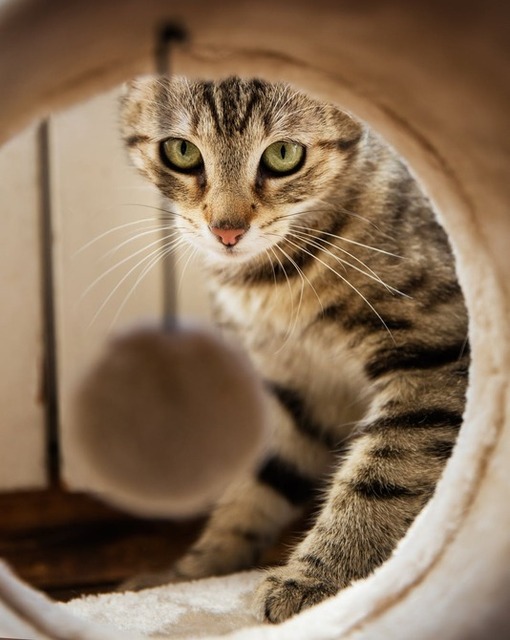
What everyday situation or a type of interaction with their pets can be considered common for all pet owners? We all call our beloved paw friends by their names, if we want to feed them, pet them, play with them or prepare them for a walk (if they are dogs). Recognizing their name and responding to it when called (recall) is a basic obedience task that owners would like their pets to fulfill. Recall is usually a task that dogs have been trained to perform. We do not hear often about cats who respond to their names.
Cats are considered way more stubborn than dogs and many people still think of them as completely untrainable animals. We would like to assure you that this is not the case. Cats actually can be trained. Of course, it does not mean that the process will be easy, and you will accomplish your training goals as quickly as you want. You need to be very patient and know your cat very well. If you are a cat owner who wants to train their little cute friend to respond to their name, this article is just for you.
What to Know Prior to Start Training Your Cat to Recognize Their Name
1. Choose a Name
If you are a new cat parent and your kitty still does not have a name, it is a time to choose a suitable name. For better and quicker results you may need to opt for a short and easily recognizable name, that will sound pleasant. Avoid long names like “Sir Jonathan Fluffy the Great” or “Lady Arabella the Gorgeous” (Arabella means “answer to my prayers” in Latin, so we actually do like this name) and similar fancy names. The shorter the name is, the better the results will be. You still can give your kitty a fancy name, but use its shorter version for training purposes.
2. Do not Change the Name
Once you pick the name that you want your cat to recognize and respond to, it should remain the same. Otherwise, your cat may get confused. Be consistent during the training process.
3. You Should not Overuse the Chosen Name
If you want to make sure that the name will mean something to your cat and will be recognized as a sign for them to come, do not use it often. If you overuse it, it may turn it into a random word, perceived
by your cat as a part of the background
noise.
4. Start Training at a Young Age
The earlier you start training your cat, the quicker you are likely to achieve results. If your cat is already an adult, do not worry, you still can train them tricks. However, it may take more time for the training to succeed.
5. Know Your Cat’s Taste
It is important to know what your cat likes, respectively what will motivate him/her to fulfill the given tasks. If you already trained a dog, you may know, that dogs should be motivated via primary positive reinforcement at the beginning (treats) and gradually start being motivated via secondary positive reinforcement (praising, petting) that replaces rewarding in the form of food. Compared to dogs, cats can hardly be encouraged to perform a task via praising/petting only. Of course, you can incorporate your kitty’s favorite toys like laser pointers or toys, including feathers. You should be familiar with your cat’s taste and choose treats or eventually toys that will motivate them most. You may need to try different flavors, until you find out which one will have the biggest effect on your kitty’s motivation.
6. Know Your Cat’s Temperament, Habits and Limitations
Knowing your cat includes not only knowing their taste, but their personality in general. Based on your cat’s personality in general, you will know what things would annoy them, when would be the most appropriate time to start with the training sessions, how easily they get distracted or bored. All the information you have about your cat will help you adapt the training to their character.
6. Do Not Train Your Cat After They Have Already Eaten
If your kitty just ate a big portion of their favorite food, they are not likely to feel encouraged enough to do some “work”. It is recommended that you provide the training sessions prior to feeding your cat.
7. Remember to Use Positive Reinforcement
Things are not likely to happen at first attempt, so do not be disappointed. Do not show any aggression-verbally or physically, towards your kitten. This will cause only stress in them and their willingness to participate in the training will decrease immensely. Stay positive!
8. Let Your Family Members/Relatives/Friends Participate in the Training Sessions
If you can not spend enough time with your kitty during the day, your family members or roommates may join the training as well. They should call your cat with the same name, and follow the same structure of training. Let them know that they should not overuse your cat’s name, and they should be very gentle and consistent.

Steps On How to Train Your Cat to Recognize Their Name
1. Prepare Treats
Since you already know your cat’s taste, you should prepare enough amount of treats of their favorite flavor.
2. Choose a Proper Location
You should choose a room in your home with no distractions in it. Turn off the TV and remove all objects, that your cat may be interested to play with or investigate. Ensure that it is a calm area with no sounds or smells, that may redirect your cat’s attention.
3. Call Your Cat by Their Name
Call your kitty by name. Also, you can add “come” or “here”, i.e., “Maya, come”. Remember to not change the words you are using.
4. Reward the Good Behavior
If your cat looks at you, say a cue word like “Yes” or “Right” enthusiastic and give them a treat. Reward right after your cat looked at you, so that he/she can associate the reward with the behavior. Your kitty needs to associate the “recall” with something pleasant that will keep them motivated.
4. Your Cat Looks Away
If your kitty looks away, repeat the third step, so that you can reinforce the association with your kitty’s name.
5. Increase the Distance
If your cat looks at you, you can make a small step back after you called them by name so that they can come closer to you. Increase the distance step by step.
6. Call Your Cat by Name Only During the Training Sessions
In the next several days try to not call your cat by their name unless during the training sessions.
6. Keep the Sessions Short and Frequent
You may need to keep the sessions no longer than 2-3 minutes per session (cats may get distracted even easier than dogs) and repeat the steps many times throughout the day.
7. Change Your Position (Gradually)
If you started the training sessions in a standing position, you can switch to a sitting position after a few days. Your cat should be able to respond in various situations and contexts.
9. Change the Location
If you think that your kitty already responds quite well to the given commands in the room where training started, you can move to another room and repeat the steps. You can conduct training in every room in your house/ apartment, as well as in the backyard (if you live in a house).

10. Try to Reduce the Amount of Given Treats
As we mentioned above, cats are strongly motivated by food and are not likely to have interest in other positive reinforcement tools. However, you still can try to reduce the amount of the treats that your kitty receives as a reward. That way you will ensure that:
-your cat will not gain weight;
-your cat will respond to your commands even when getting treats occasionally (you can not hold treats every time you call your kitty).
In order to fulfill this step, you can try to make some variations in the given reward, i.e. if your cat desire to get access to a certain place in your home, that they are not usually allowed in, you can give them access to it. Also, you can start incorporating their favorite toys in order to reduce the treats.
11. Keep Repeating the Steps
Repeat the steps above for several weeks until your kitty masters the command.
Your Cat Does Not Respond to Your Commands
If your cat does not seem to be very responsive, there are two reasons for that:
1. Your Cat Is Stubborn and Obstinate
In this case you should be extremely patient, consistent and prepare a lot of treats. If your cat is already an adult, it may take longer to achieve the desired results. Also, you can consult a cat behaviorist.
2. Make Sure That Your Cat Does Not Have Hearing Problems
You can try using different sounds to check how your cat responds to them. If you worry that your paw friend may have hearing impairments, you should consult a veterinarian.
Training a cat may be a demanding task, however, it is not impossible. Cats can be taught a lot of tricks. You just need to show your qualities as a loving owner and a good trainer.












